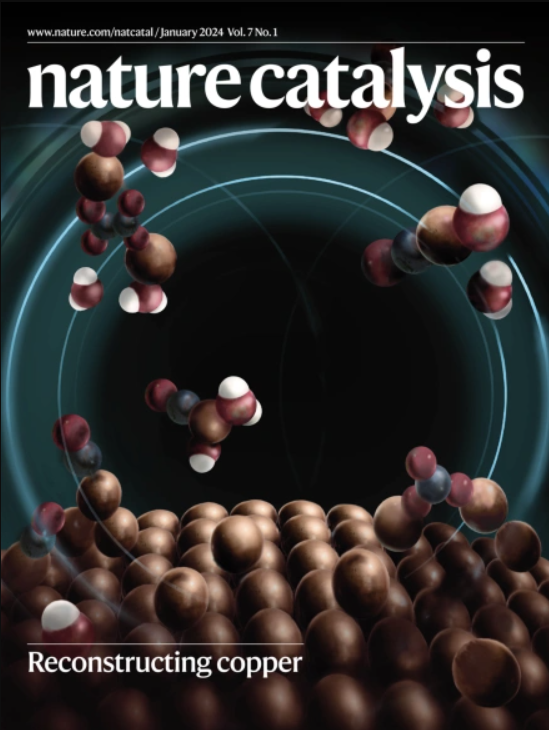Perovskite-driven solar C2 hydrocarbon synthesis from CO2
IF 44.6
1区 化学
Q1 CHEMISTRY, PHYSICAL
引用次数: 0
Abstract
Photoelectrochemistry (PEC) presents a direct pathway to solar fuel synthesis by integrating light absorption and catalysis into compact electrodes. Yet, PEC hydrocarbon production remains elusive due to high catalytic overpotentials and insufficient semiconductor photovoltage. Here we demonstrate ethane and ethylene synthesis by interfacing lead halide perovskite photoabsorbers with suitable copper nanoflower electrocatalysts. The resulting perovskite photocathodes attain a 9.8% Faradaic yield towards C2 hydrocarbon production at 0 V against the reversible hydrogen electrode. The catalyst and perovskite geometric surface areas strongly influence C2 photocathode selectivity, which indicates a role of local current density in product distribution. The thermodynamic limitations of water oxidation are overcome by coupling the photocathodes to Si nanowire photoanodes for glycerol oxidation. These unassisted perovskite–silicon PEC devices attain partial C2 hydrocarbon photocurrent densities of 155 µA cm−2, 200-fold higher than conventional perovskite–BiVO4 artificial leaves for water and CO2 splitting. These insights establish perovskite semiconductors as a versatile platform towards PEC multicarbon synthesis. Hydrocarbon selectivity in photoelectrochemical CO2 reduction has been limited due to a lack of low-overpotential catalysts and high-photovoltage semiconductors. Here Cu nanoflowers are interfaced with perovskite light absorbers for bias-free conversion of CO2 to ethane and ethylene coupled to water or glycerol oxidation.


钙钛矿驱动的二氧化碳太阳能C2碳氢化合物合成
光电化学(PEC)通过将光吸收和催化集成到紧凑的电极中,为太阳能燃料合成提供了一条直接途径。然而,由于催化过电位高和半导体光电压不足,PEC的碳氢化合物生产仍然难以实现。在这里,我们展示了将卤化铅钙钛矿光吸收剂与合适的铜纳米花电催化剂相结合来合成乙烷和乙烯。得到的钙钛矿光电阴极在0 V条件下对可逆氢电极产生C2烃的法拉第产率为9.8%。催化剂和钙钛矿几何表面积强烈影响C2光电阴极的选择性,表明局部电流密度在产物分布中起作用。通过将光电阴极与硅纳米线光电阳极耦合用于甘油氧化,克服了水氧化的热力学限制。这些无辅助的钙钛矿-硅PEC装置获得了155µA cm - 2的部分C2碳氢化合物光电流密度,比传统的钙钛矿- bivo4人工叶片高200倍,用于水和二氧化碳的分解。这些见解确立了钙钛矿半导体作为PEC多碳合成的通用平台。
本文章由计算机程序翻译,如有差异,请以英文原文为准。
求助全文
约1分钟内获得全文
求助全文
来源期刊

Nature Catalysis
Chemical Engineering-Bioengineering
CiteScore
52.10
自引率
1.10%
发文量
140
期刊介绍:
Nature Catalysis serves as a platform for researchers across chemistry and related fields, focusing on homogeneous catalysis, heterogeneous catalysis, and biocatalysts, encompassing both fundamental and applied studies. With a particular emphasis on advancing sustainable industries and processes, the journal provides comprehensive coverage of catalysis research, appealing to scientists, engineers, and researchers in academia and industry.
Maintaining the high standards of the Nature brand, Nature Catalysis boasts a dedicated team of professional editors, rigorous peer-review processes, and swift publication times, ensuring editorial independence and quality. The journal publishes work spanning heterogeneous catalysis, homogeneous catalysis, and biocatalysis, covering areas such as catalytic synthesis, mechanisms, characterization, computational studies, nanoparticle catalysis, electrocatalysis, photocatalysis, environmental catalysis, asymmetric catalysis, and various forms of organocatalysis.
 求助内容:
求助内容: 应助结果提醒方式:
应助结果提醒方式:


